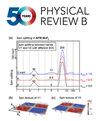一维晶格中通过可调近邻相互作用的拓扑相变
IF 3.7
2区 物理与天体物理
Q1 Physics and Astronomy
引用次数: 0
摘要
研究了具有可调谐近邻相互作用的硬核玻色子或无自旋费米子的一维模型的相图。通过在连续键上引入交替的排斥和吸引相互作用,我们发现在固定的排斥相互作用下,随着吸引相互作用强度的增加,系统经历了从键有序(BO)相到电荷密度波ii相的量子相变。对于特定的相互作用模式,BO相表现出拓扑性质,当模式改变时,这些性质就会消失,从而导致从拓扑BO相转变为普通BO相,通过一个闭合点,两种相互作用都消失。我们使用有序参数、拓扑不变量、边缘状态分析和Thouless电荷泵浦的组合来识别这些相位。通过将我们的分析扩展到半填充之外,我们探索了所有密度下的相图,并确定了超流体和对超流体相,其特征是在不相称密度下的单粒子和束缚对激励。该模型可在光学晶格中的里德堡激发或超冷原子等平台上实验实现,为研究低维系统中拓扑和相互作用之间的相互作用提供了一个通用的框架。最后,我们给出了连续键上所有可能的相互作用强度(排斥或吸引)的完整基态相图。本文章由计算机程序翻译,如有差异,请以英文原文为准。
Topological phase transition through tunable nearest-neighbor interactions in a one-dimensional lattice
We investigate the phase diagram of a one-dimensional model of hardcore bosons or spinless fermions with tunable nearest-neighbor interactions. By introducing alternating repulsive and attractive interactions on consecutive bonds, we show that the system undergoes a quantum phase transition from a bond-ordered (BO) phase to a charge-density wave-II phase as the attractive interaction strength increases at a fixed repulsive interaction. For a specific interaction pattern, the BO phase exhibits topological properties, which vanish when the pattern is altered, leading to a transition from a topological BO phase to a trivial BO phase through a gap-closing point where both interactions vanish. We identify these phases using a combination of order parameters, topological invariants, edge-state analysis, and Thouless charge pumping. By extending our analysis beyond half filling, we explore the phase diagram across all densities and identify the superfluid and the pair-superfluid phases, characterized by single-particle and bound-pair excitations at incommensurate densities. The proposed model is experimentally realizable in platforms such as Rydberg excited or ultracold atoms in optical lattices, offering a versatile framework to study such interplay between topology and interactions in low-dimensional systems. Finally, we present the complete ground-state phase diagram for all possible signs of the interaction strengths, repulsive or attractive, on consecutive bonds.
求助全文
通过发布文献求助,成功后即可免费获取论文全文。
去求助
来源期刊

Physical Review B
物理-物理:凝聚态物理
CiteScore
6.70
自引率
32.40%
发文量
0
审稿时长
3.0 months
期刊介绍:
Physical Review B (PRB) is the world’s largest dedicated physics journal, publishing approximately 100 new, high-quality papers each week. The most highly cited journal in condensed matter physics, PRB provides outstanding depth and breadth of coverage, combined with unrivaled context and background for ongoing research by scientists worldwide.
PRB covers the full range of condensed matter, materials physics, and related subfields, including:
-Structure and phase transitions
-Ferroelectrics and multiferroics
-Disordered systems and alloys
-Magnetism
-Superconductivity
-Electronic structure, photonics, and metamaterials
-Semiconductors and mesoscopic systems
-Surfaces, nanoscience, and two-dimensional materials
-Topological states of matter
 求助内容:
求助内容: 应助结果提醒方式:
应助结果提醒方式:


